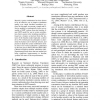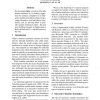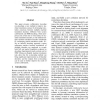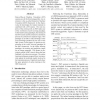IMCSIT
2010
14 years 12 days ago
2010
Abstract--A Web-based system for human evaluation of machine translation is presented in this paper. The system is based on comprehension tests similar to the ones used in Polish m...
EMNLP
2009
14 years 28 days ago
2009
This paper investigates the effect of direction in phrase-based statistial machine translation decoding. We compare a typical phrase-based machine translation decoder using a left...
EMNLP
2009
14 years 28 days ago
2009
Training a statistical machine translation starts with tokenizing a parallel corpus. Some languages such as Chinese do not incorporate spacing in their writing system, which creat...
EMNLP
2009
14 years 28 days ago
2009
Binarization of Synchronous Context Free Grammars (SCFG) is essential for achieving polynomial time complexity of decoding for SCFG parsing based machine translation systems. In t...
EMNLP
2009
14 years 28 days ago
2009
Recently system combination has been shown to be an effective way to improve translation quality over single machine translation systems. In this paper, we present a simple and ef...
ACL
2009
14 years 1 months ago
2009
We developed caitra, a novel tool that aids human translators by (a) making suggestions for sentence completion in an interactive machine translation setting, (b) providing altern...
ACL
2009
14 years 1 months ago
2009
This paper presents collaborative decoding (co-decoding), a new method to improve machine translation accuracy by leveraging translation consensus between multiple machine transla...
NAACL
2010
14 years 1 months ago
2010
State-of-the-art Machine Translation (MT) systems are still far from being perfect. An alternative is the so-called Interactive Machine Translation (IMT) framework. In this framew...
NAACL
2010
14 years 1 months ago
2010
This paper presents a direct word reordering model with novel syntax-based features for statistical machine translation. Reordering models address the problem of reordering source...
EMNLP
2010
14 years 1 months ago
2010
We examine effects that empty categories have on machine translation. Empty categories are elements in parse trees that lack corresponding overt surface forms (words) such as drop...




